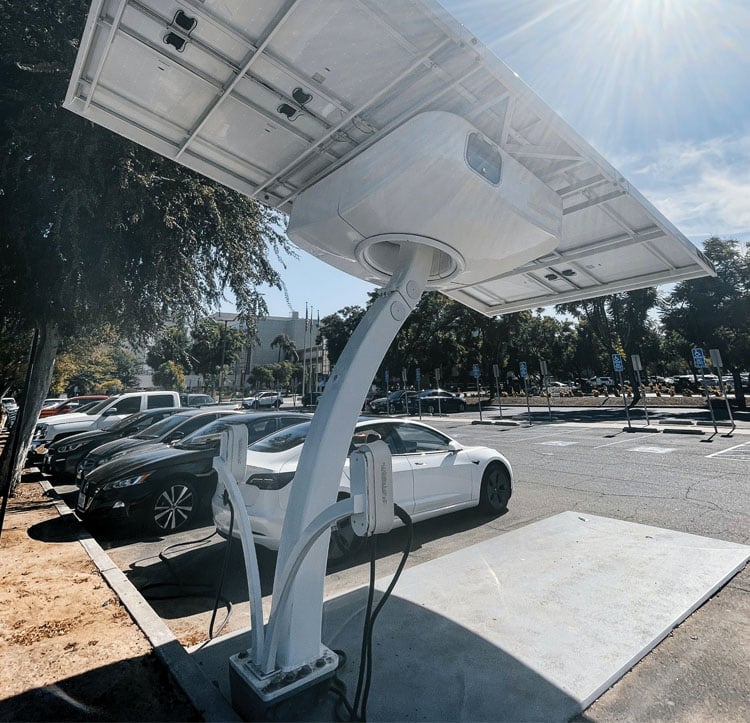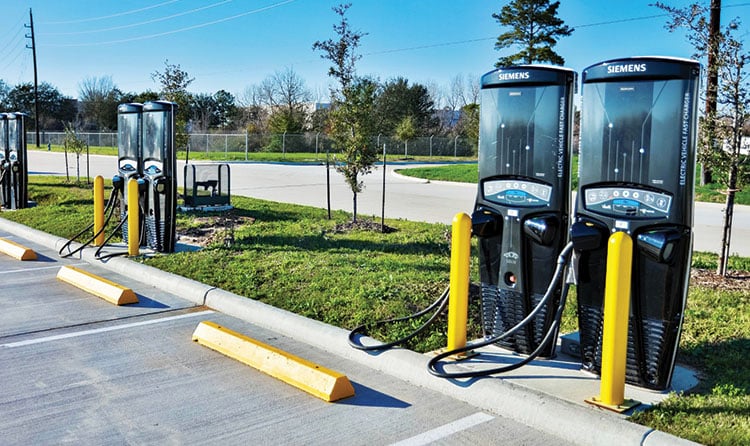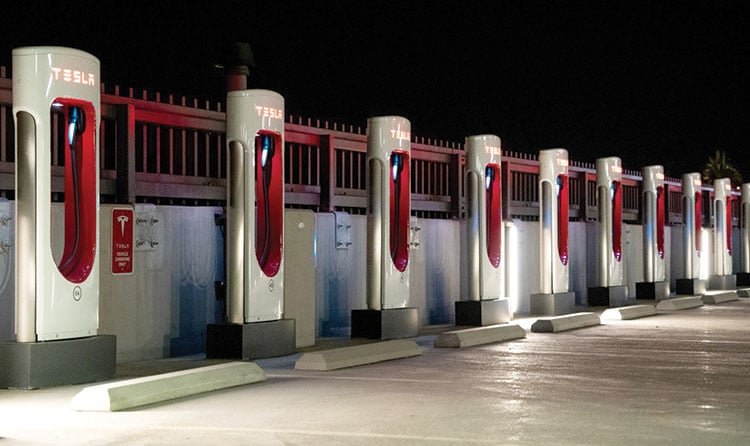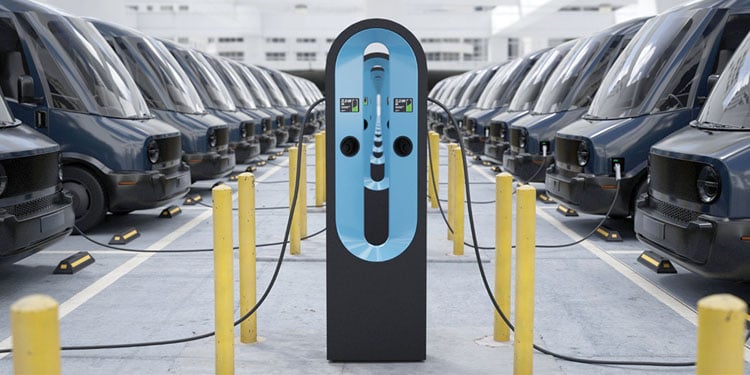Preparing a parking facility for electric vehicle charging requires a strategic power assessment to ensure sufficient electrical capacity and long-term scalability.
By Jacob Gonzalez
The transition to greater electric vehicle (EV) usage is accelerating, and institutions like universities, government agencies, and business complexes are increasingly recognizing the need to provide EV charging infrastructure. Among the reasons for adding EV charging capabilities, perhaps the most prominent is the automobile industry’s steady move toward an all-electric future. Although major automakers have set different targets for transitioning to all-electric lineups, most have ambitious goals to reach this target between 2030 and 2050.
Last year, 8.1% of all new cars sold in the United States were electric, amounting to 1.3 million new EVs, increasing the total number of such vehicles on American roads and highways to 4.6 million. For government agencies, universities, and owners of private buildings or complexes, adding EV charging capacity is a must.
In the short-term, EV adoption will continue to be fastest among fleet and large organizational operators who can gain economy of scale and have prioritized redundancy, cost optimization, physical density, and other factors that may not be present in a “normal” parking facility that’s used by many types of vehicles. Still, the auto industry’s march to an all-electric future is well underway, and all parking owners will need to start adding, sooner rather than later, the necessary infrastructure to power these vehicles.

However, many institutions and private owners don’t know where to start. After all, it’s not a matter of just dropping new chargers into the ground. First, several questions must be answered: Do we have the power? How much power do we need? How much power are we currently using?
Large-scale EV charging loads can be staggering — often multiples of a building’s base load — and require new dedicated utility services. Although smaller EV charging projects can be added to the existing building infrastructure, their loads can be large as well: 20% to 30% of a building’s base load is common. Therefore, before jumping into installation, it’s essential to conduct a comprehensive power assessment. This is a vital first step toward establishing realistic projects to add EV charging.
During the past 3 years, our team has provided project management for one of the largest EV infrastructure development programs in the United States. The lessons I have learned can help organizations navigate the complexities of EV infrastructure development, ensuring that they start with a solid foundation. The most important thing I’ve learned is that the process should always start with a power assessment.

Understanding the scope of a power assessment
A power assessment involves more than simply evaluating the anticipated energy demand of charging stations; it requires a holistic view of all systems relying on electricity from the same source. Rarely do EV chargers operate independently. On university campuses, at government buildings and installations, and in business complexes, the same electrical infrastructure will also provide power to buildings, labs, and various systems. Even in stand-alone parking facilities, other systems — including lighting, elevators, parking technologies, and ventilation systems — require power. Emergency power requirements also need to be considered.
A proper power assessment entails analyzing the full spectrum of electrical demands across a campus or facility and the power requirements of future improvements, whether for EV charging or other initiatives. This means looking at all nearby buildings, infrastructure, and any other systems that draw electricity from the transformer that will also supply power for the EV charging stations. By understanding the full scope of energy consumption, organizations can avoid potential roadblocks that could derail their plans.

The four steps of an assessment
The assessment process begins by collecting and analyzing 12 months of historical electricity usage data. This step, which may be as simple as looking at the last 12 months of electric bills, provides a baseline for understanding current consumption patterns and peak demand periods. The next step involves estimating the additional energy load that the planned EV charging stations will introduce. The third step requires evaluating the existing electrical infrastructure to establish its spare capacity for use by EV chargers. A potential fourth step entails considering adding new electrical services to the building. By combining these data points, organizations can build a framework for their energy requirements, identifying any potential impediments that might prevent successful implementation.
Many EV charging projects fall apart at this point. If the power assessment reveals that the existing transformer lacks sufficient capacity to handle both the current and anticipated future loads, many organizations simply put their plans on hold for fear of the complexity and the additional cost associated with increasing capacity. Although understandable, this reaction is unnecessary and counterproductive.
Transformer capacity issues can be resolved with proactive planning and collaboration with the local utility provider. Utilities often view these upgrades favorably because they result in increased electricity sales. In many cases, the utility will assume much of the cost of upgrading transformers, though the property owner will still be responsible for purchasing certain necessary equipment.
Working closely with an experienced EV consulting team that has strong relationships with the utility is essential in this phase. The team can facilitate discussions, advocate for necessary upgrades, and ensure that the utility provider understands the long-term benefits of the project. By demonstrating that increased power demand will be sustained over time, organizations can increase the likelihood of a utility approving and investing in the necessary upgrades.
The power assessment can also serve as a catalyst for broader improvements to an organization's electrical infrastructure. For example, an outdated lighting system could be replaced with energy-efficient LED lighting, which not only provides better illumination but also reduces overall power consumption. Additionally, institutions may explore the integration of renewable energy sources, such as solar panels, to supplement their electricity needs. By leveraging solar power, organizations can offset some of the increased demand from EV charging stations, reducing reliance on grid electricity and lowering long-term operational costs. Of course, adding renewable energy capabilities also aligns with the organizational values of universities, government agencies, and others that promote sustainability in their everyday operations.
Among large power users, another growing trend involves switching to primary metering. In this approach, a power user owns its own medium-voltage to low-voltage transformers and obtains a primary voltage meter — typically between 4,160V to 35kV — to receive substantially lower electrical rates typically offered by a utility.

Developing a long-term power strategy
The insights gained from a thorough power assessment enable organizations to develop a strategic plan for their electrical infrastructure. Instead of reacting to capacity limitations as a roadblock, they can proactively address power needs and incorporate upgrades that will serve them well into the future.
By understanding current and future energy requirements, decision-makers can ensure that their EV charging initiative aligns with broader sustainability and operational goals. They can also future proof their electrical systems, ensuring scalability as the demand for EV charging continues to grow.
In fact, this process may also present the perfect opportunity for organizations to analyze and address their electric needs across campus. Your EV consulting team should also be able to help with planning for anticipated load requirements and building capacity across campus, or for a building or institution.
Adding EV charging stations to a campus, government facility, or business complex is a significant but necessary step for meeting the day-to-day needs of EV drivers. As more drivers switch to electric vehicles — and as the auto industry transitions to fully electric fleets — the need for EV charging infrastructure will continue to grow. In this process, conducting a comprehensive power assessment is absolutely essential. Skipping this crucial first step can lead to costly delays and preventable setbacks.
By evaluating the current energy usage of all buildings and systems (not just EV charging), anticipating future needs, and working closely with utility providers, organizations can ensure a smooth, successful implementation of EV charging infrastructure. Furthermore, this process often presents opportunities to upgrade other electrical systems, improving overall efficiency and sustainability.
As someone who has provided project management to one of the largest EV fleet conversion projects in the United States, I have seen firsthand the crucial nature of this initial power assessment. With the right approach, institutions can turn potential obstacles into opportunities, paving the way for a seamless transition to electric mobility.
JACOB GONZALEZ is vice president of client solutions for WGI Inc. He can be reached at Jacob.Gonzalez@wginc.com.














